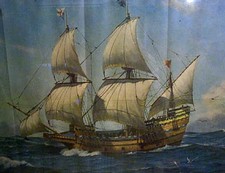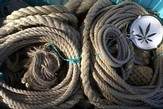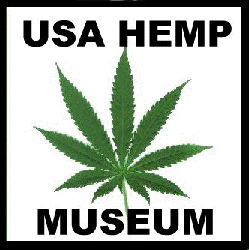 |
HEMP ROPE & TWINE ROOM
USA Hemp Museum
Store |
|
|
ROOM GUIDE |
Ropes from the U.S.A. Hemp Museum. |
||||||||||||||||
|
|
1. WELCOME TO THE HEMP ROPE & TWINE ROOM. "Once upon a time, hemp rope was more famous than hemp flowers."
|
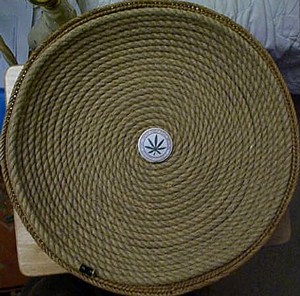 |
The first hemp rope acquired for the U.S.A. Hemp Museum was the fine quality 10 mm untarred hemp rope from Denmark that forms the background for this room (shown at left coiled in a basket. This rope is imported into the U.S. and comes in a variety of sizes. The kind people at the U.S. Marine Maritime Museum of San Francisco helped me find a vendor in the U.S. |
2. THE HISTORY OF ROPE & TWINE.
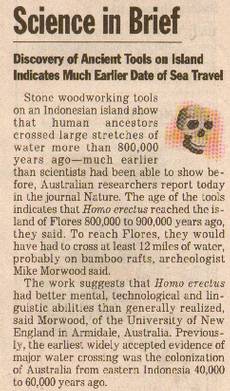 |
How early did our ancestors make
ropes? The discovery of wood working tools on the island
of Flores in Indonesia shows that early man made rafts of bamboo
lashed together probably with vines or rawhide ropes.
Could hemp ropes have been far behind? Hemp rope, twine and fishnets probably predate the weaving of fabric. Hemp rope and saddles set up a human to horse relationship that exists to the present. The oldest saddle ever found was made of hemp by the Scythians of the Siberian steppes, thousands of years ago. |
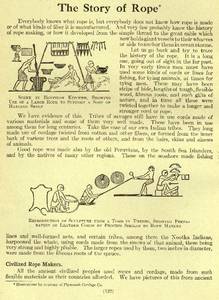 |
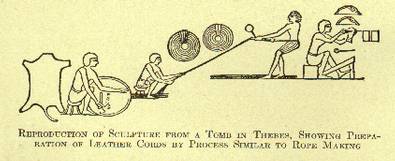 |
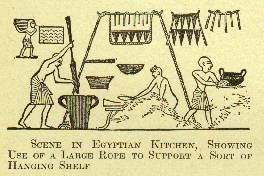 |
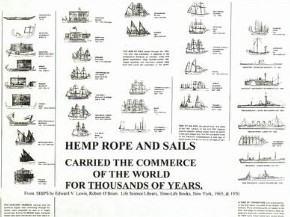 |
The history of hemp rope in sailing the seas extends back many thousands of years. |
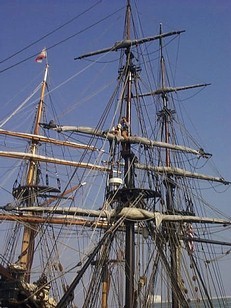 |
The rigging of the Hawaiian Chief in Long Beach Harbor gives an idea of the many ropes of a modern day tall sailing ship. |
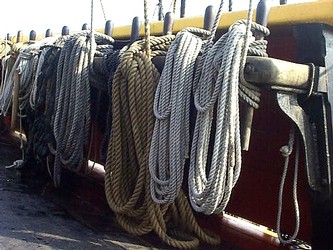 |
It is amazing the amount of rope needed to operate one of these wind powered tall ships. |
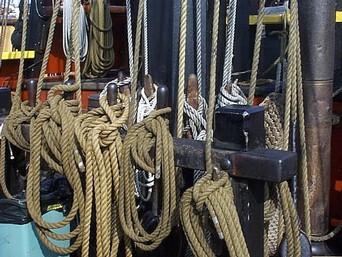 |
On a modern sailing ship you can
find several different kinds of rope.
Little hemp is used due to availability and cost. Ending hemp prohibition ends the price problem because hemp is an easily renewable resource material that can produce up to 4 crops a year. |
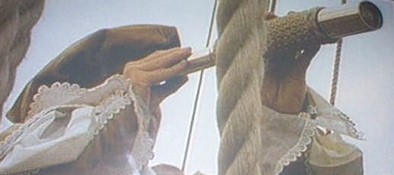 |
The thick rope and macramaİ spyglass cover are from a shot taken off the History Channel series of Great Ships. |
 |
"Back on the plain the trebuchets were being swiftly assembled by groups of engineers. The trebuchets looked ungainly - oversized slingshots with heavy wooden beams bracing the armature for the firing paddle, which was winched back by stout hemp ropes, then released to snap upward, flinging its payload over the castle walls." [A.D. 1357] From TIMELINE, By Michael Crichton. 1999. |
| A.D. 1783. Joseph Michel Montgolfier (1740-1810), famed papermaker of France, invented first practical balloon. [Want to bet hemp was there?] |
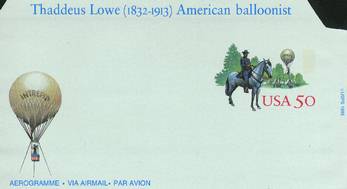 |
Official U.S. Post Office envelope commemorating the American balloonist Thaddeus Lowe (1832 - 1913). (pictured below on reverse side of envelope.) |
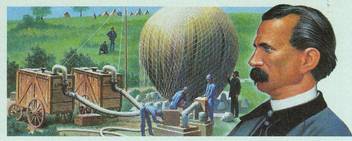 |
Thaddeus Lowe stands next to the
hemp rope covered balloon sack made of silk.
The large flexible hoses for hydrogen are likely hemp. |
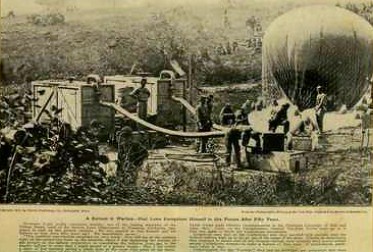 |
Hemp Museum picture of the same
balloon being filled by portable hydrogen generators during the
Civil War.
Lowe stayed aloft in the balloon over the battle, out of range of the guns. |
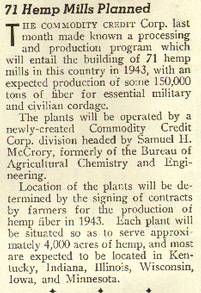 |
TEXTILE ARTS MAGAZINE, 1942. FOR THE WORLD WAR II WAR EFFORT, 71 HEMP MILLS WILL BE BUILT IN 1943, PRODUCING 150,000 TONS OF FIBER FOR ESSENTIAL MILITARY AND CIVILIAN CORDAGE. |
|
3. THE HEMP MUSEUM ROPE & TWINE |
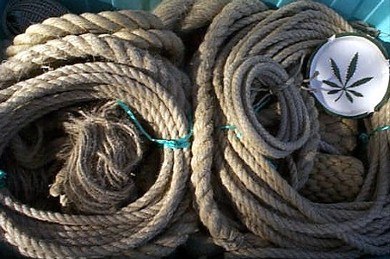 |
Some of the museum ropes from Holland, Denmark, and Hungry are shown here (left & above). The unbraided end of a large rope (left center) shows the many yarns that make up one large rope. |
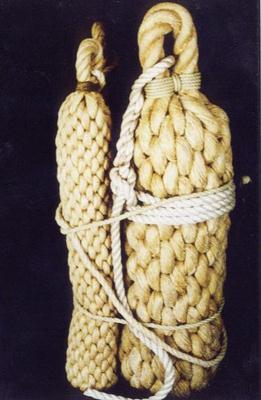 |
These Hemp Museum "fenders" are
hung over the side of boats and ships to serve as bumpers when
docked. They show the beautiful golden color of natural
hemp. From Holland.
|
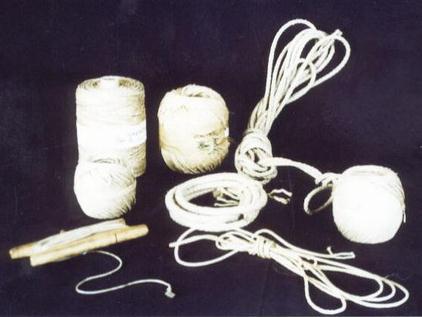 |
These small ropes and twines of the Hemp Museum are all made of hemp. The long fibers of hemp, running the length of the stalk, are ideal for rope and twine. From Holland and China. |
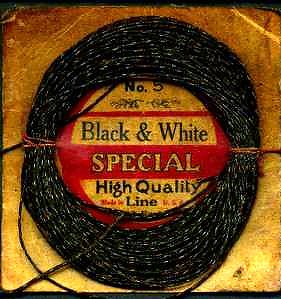 |
Sometimes items are collected for the hemp museum I suspect are hemp, but don't know for sure. This braided fishing line is such an item. Fishing line and fish nets are possibly one of the oldest uses for the hemp plant by humans. In hunting and gathering societies, food rules. |
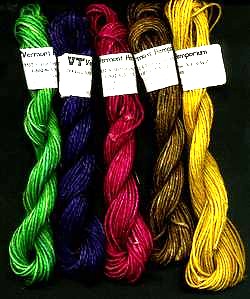 |
Samples of dyed hemp macramaİ twine. |
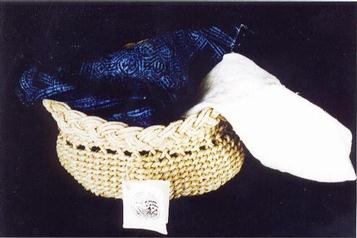 |
Hemp twine basket made in Hawaii. |
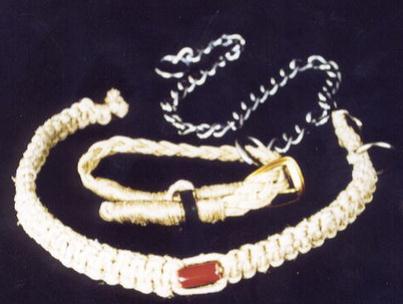 |
Hemp twine dog collars. The
one with the red bead is a commercial product.
The small one was made by the curator for the hemp museum. |
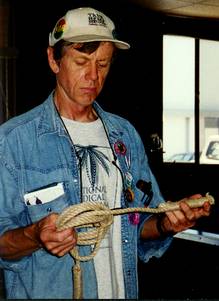 |
Curator with one of his hemp jump ropes, with hemp twine handles. |
6. ROPE RELATED POT LABELS.
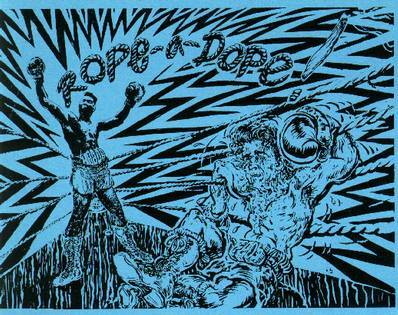 |
For the Hemp Rope and Twine Room we have our rope related pot brand label from the 1980's. Thanks to Anonymous for the contribution of labels to the museum. |
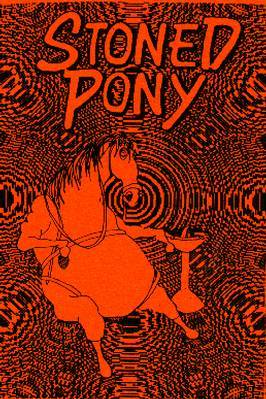 |
Another brand label from the 1980's showing why horses are so mellow. This one may be from the Siberian steppes where hemp grows wild to this day. More labels are found in other rooms, adding a little humor, color and creativity to the Hemp Museum. |
|
***** 7. BENJAMIN FRANKLIN'S HEMP STRING. THE CHILD'S BOOK OF NATURE. By Worthington Hooker, M.D. 1888. Harper & Brothers, New York. In Chapter XXX, More About Electricity, Hooker explains Benjamin Franklin's experiment by which he discovered that lightning and electricity are the same thing. Franklin sent his silk kite up in a thunderstorm with a pointed iron wire attached to the kite and the string. The silk was a non-conductor, while the string conducted the electricity to the ground. "But he managed to prevent the electricity from coming to his hand. He stopped it on the way. He did this by tying a silk ribbon to the hemp string, and holding the kite by this ribbon, as you see in the picture. The electricity could not go through this silk, and so it stayed in the hemp string."
|
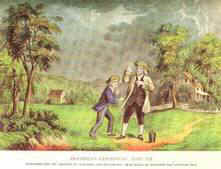 |
FRANKLIN'S EXPERIMENT, JUNE 1752. "Demonstrating the Identity of Lightning and Electricity, From Which He Invented the Lightning Rod. From "Currier & Ives," Ed. by John L. Pratt, 1968. |
|
"Dr. Franklin now
fastened a key to the end of the hemp string. A great deal of the
electricity now passed to the key, because the metal of which the key was
made was so good a conductor. When Franklin put his knuckle near the key,
he received a shock from it." These experiments by Franklin suggested the use of lightning rods, which he invented. A lightning rod saved the museum curator's house, when a homemade lightning rod carried a huge bolt of lightning to a metal rod pounded eight feet into the ground. The blast was tremendous, but only two radios were lost, thanks to Ben. |
*****
12. ROPE & TWINE PRODUCTS.
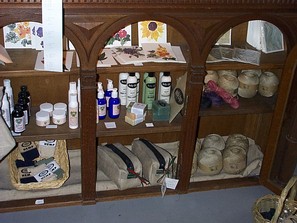 |
Hemp twine for sale in a California hemp store. |
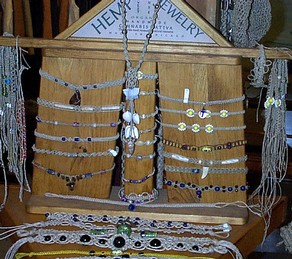 |
Hemp twine jewelry display in a California hemp store. |
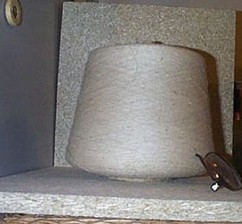 |
Hemp yarn from China, sitting on Medium Density Fiberboard of Hemp from Poland. |
*****
If you would like to join the USA Hemp Museum
or communicate with the curator, send an
email to
Richard M. Davis:
Curator, Founder, Author
Help support the USA Hemp Museum
Please Make A Donation
To The USA Hemp Museum's Building Fund
So We Can Make Public Our Collection
Of Over 1,700 Hemp History Items
Donate
and/or buy the books
HEMP ROPE & TWINE HAVE BEEN USED SINCE MANKIND BECAME DOMESTICATED. |
USA Hemp Museum Store - Bookmark This Site - Museum Link - Email The Museum
